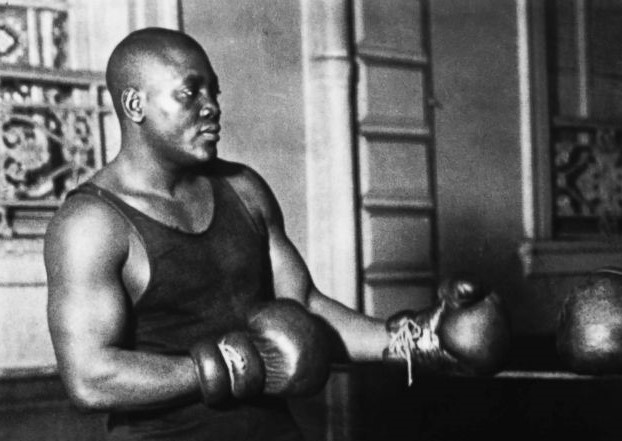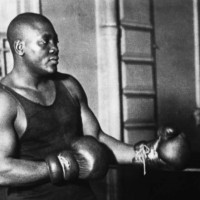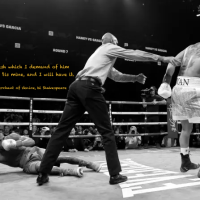The spectre of a new debate about the potential outcome of clashes between the modern day heavyweight and his predecessors will fail to entice those for whom the discussion is a tired exchange of old arguments.
However, Andrew Mullinder has found a new mathematical angle which proves far more thought provoking than you might presume. Using the standard physiological growth of the human populous, Mullinder extrapolates the weights of the bygone legends to create, among others, a 240 pound Jack Johnson.
A formidable prospect and one likely to strike fear into all but the greatest of greats.
Resizing the big men
By Andrew Mullinder
In a way, there is some of the four barbers from Eddie Murphy’s Coming to America in all of us. I’m sure I’m not alone in having spent countless blissfully unproductive hours on forums and in bars having some version of the immortal Queens barber shop Joe Louis vs. Rocky Marciano conversation.
“You must be out yo goddamn mind! Joe Louis is the greatest boxer that ever lived. He was better than Cassius Clay, he was better than Sugar Ray, and that new dude, what’s his name, Mike Tyson, looks like a bulldog, he was better than him too.”
“What about Rocky Marciano?”
“There they go, every time I start talkin ’bout boxing, a white man gotta pull Rocky Marciano outta his ass. That’s their one, that’s their one. Rocky Marciano. Rocky Marciano. Let me tell you something once and for all. Rocky Marciano was good, but compared to Joe Louis, Rocky Marciano ain’t shit.”
In most other sports, improvements in training, tactics and equipment make hypothetical contests between, say, Rafael Nadal and Rod Laver, or Tom Brady’s Patriots and Bart Starr’s Packers, unworkable. Of course, trophies accrued and performance against contemporaries can be compared, but that can not realistically be extended to imaginary contests.
Not so with boxing. Equipment stretches no further than gloves, cup, gumshield and shorts; humans may be bigger now, but welterweights and lightweights weighed the same in 1928 as they do today. We really can imagine what would have happened if Kid Gavilan fought Tommy Hearns, or Roberto Duran slugged with Julio Cesar Chavez.
In the heavyweight division, however, things get more complicated.
Without an upper weight limit, heavyweights have gotten bigger at the same rate as the general population and other athletes have increased in size. Of course, the plodding, technically retarded 240lbers that claim to be the heavyweight elite these days will have persuaded many that size is irrelevant, and that 189lb Rocky Marciano would dong 245lb Vladimir Klitschko as soon as the bell went ding. But that’s not really what ‘what if’ boxing is all about. It’s all about imagining what would happen if two greats from different eras exchanged blows, not what a hall of famer would do with today’s tomato can emeritus. And as plenty of slothful hacks will no doubt remind us as Dela Hoya – Paquiao approaches, a good big’un beats a good little’un.
Unfortunately, it is easy to understand why many of our heavyweight time machine matches flounder on this issue. The aforementioned Brockton Blockbuster, for instance, would have given up approximately ten inches and about 50lbs to a prime Lennox Lewis. To put that in perspective, Marciano had around 78 percent of the body mass of Lewis, making a match between the two the same in percentage terms as pitting Willie Pepp against Marvin Hagler.
But perhaps there is a way around this. Making all heavyweights the same size would be simplistic and haphazard. Half of the attraction of the heavyweight division is that its champion is the ‘open’ champion, unfettered by a weight limit. And besides, how does one resize and account for body shape?
But economists always account for inflation when comparing dollars, pounds, etc, from different years. Why can’t we account for the increase in size in the average male when comparing boxers? After all, Jack Johnson was probably as physically impressive to his contemporaries as Lennox Lewis is today. But what size would he have to be now to be as big in relation to other men as he was in 1910?
This experiment will be admittedly unscientific and likely inaccurate, but for fun, here goes.
In the table below, we take a fighter’s height, measure how much larger (as a proportion) he was than the average US male at the time, and use that to work out an approximate present day equivalent height if he was as much taller today as he was at his peak. We can then use his real-life body mass index (BMI), taken from his approximate peak performance dates rather than in youth or fat old-age, to work out how much he would have weighed at his new height if his body shape had stayed roughly the same.
| Boxer |
Height |
Weight |
BMI |
Human average at peak |
Height in present terms |
Weight in present terms |
| John Sullivan |
180cm (5 feet 11) |
86kg 190lb |
c.26 |
169cm |
188 (6 feet 2) |
93(205lbs) |
| Jack Johnson |
187, (6’1½) |
93kg, 205lb |
c.26 |
172cm |
192 (6’4) |
98(216) |
| Jack Dempsey |
185 (6’1) |
85kg, 187lb |
c.24 |
173cm |
189 (6’2) |
88(194) |
| Joe Louis |
188 (6’2) |
91kg 201lb |
c.25 |
176cm |
190 (6’3) |
93(205) |
| Rocky Marciano |
178 (5’10) |
84kg 185lb |
c.26 |
177cm |
178 (5’10) |
84(185) |
The statistics on height increases are not as expected. It seems that while the overall height of men has been increasing at breakneck speed in the last 150 years, American men, who entered the period as the tallest on Earth, hit a plateau in the 1950s at between 177 and 178 cm (5 feet 10), while many other nations have overtaken, leaving the US as now only the 9th tallest nation.
The reasons for this are currently being debated in anthropometric and auxology circles, but not being an ologist, I can focus on what this means to us: Marciano does not grow at all, and the earlier the fighter, the greater their increase in percentage terms.
The other surprising factor is the BMI number for each fighter. Lennox Lewis had a BMI of 29 when he fought Evander Holyfield first time around while Holyfield had a BMI of 27.5 that night, and Tyson, when he destroyed Michael Spinks, had a BMI of 31.3 – all far higher than their predecessors in the table above. One possible explanation for this phenomenon is the better modern understanding of nutrition and weight training. I doubt there were too many Mackie Shilstones or Kerry Kayeses around in Jawn Ell’s day.
What if there were? This is relevant for our experiment, because while the average American joe may not have grown since the fifties, the athletes he watches certainly have.
The three highest profile jumps to heavyweight in the last 20 years were Michael Spinks, Evander Holyfield and Roy Jones. Spinks went from 6 feet 3 and 175lb (BMI 22) to 200lb (BMI 25); Holyfield went from a BMI of 24 to 27, and Jones likewise. In other words, each man, with expert tutelage, was able to add three points to his BMI. How would our great heavyweights look, then, at their new heights and with 6 months training with Shilstone under their belts?
| Boxer |
Height in present terms |
BMI plus 3 points (Shilstone boost) |
Weight in present terms plus Shilstone BMI boost |
| John Sullivan |
6 feet 2 |
29 |
225lbs |
| Jack Johnson |
6’4 |
29 |
240 |
| Jack Dempsey |
6’2 |
27 |
210 |
| Joe Louis |
6’3 |
28 |
225 |
| Rocky Marciano |
5’10 |
29 |
205 |
Jack Johnson is now built like Lennox Lewis; Marciano is only an inch and a half shorter and five pounds lighter than Frazier was when he beat Ali the first time; Sullivan makes for a terrifying prospect at six-two and 225; Dempsey is about the same size and weight as Holyfield – although he would use the size differently -and Joe Louis does not look too different from Ali.
It changes the arguments, doesn’t it?
How would Lennox Lewis have handled a marauding, granite chinned 205lb Marciano? Could a crude but powerful 6’2 225lb John L Sullivan lick any heavyweight of the current crop? Would Jack Johnson, at 6’4 and 240, handle peak Tyson as easily as Lewis handled the shot Tyson? Joe Louis executed his punches almost perfectly, generating granite-cracking power, but even at 225lbs, would he have enough to dent Holyfield? And what kind of wars could Jack Dempsey instigate with his extra beef?











weight has no significan neither does height especially in heavyweights.
louis would have ko the boxers of today and so would iron mike.
ali would just play around them.
LikeLike
I disagree with the first half of your point but I can’t disagree with much of the second.
LikeLike